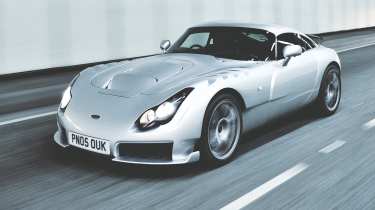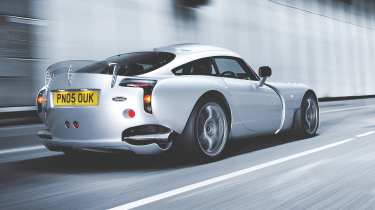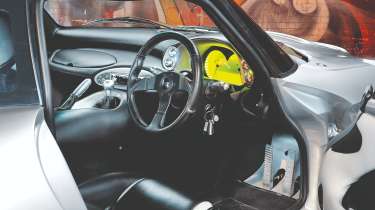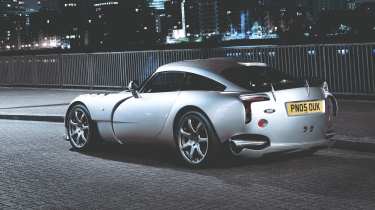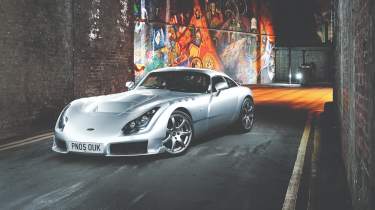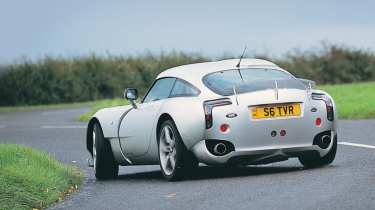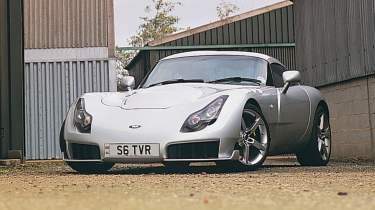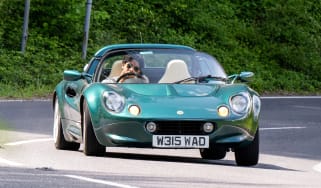TVR Sagaris (2005 - 2006): Blackpool's best saved 'til last
As TVR's revival remains in limbo, the Sagaris retains its place as the marque's last production car. It's also one of its best
The Sagaris is the car most these days have in mind when asked what a TVR is. Unsurprising, given the marque launched one of its best, most impactful, most outlandish sports cars (mad enough to play the bedroom wall pinup) last, before it was snuffed out in the mid-2000s. Subsequent attempts to revive the brand have been exciting but so far, fruitless, so it’s back to the Sagaris we still look when we want to remind ourselves of the raw, unfettered sports car experience a TVR can deliver.
More than ever, looking back on that is an exercise in lusting for what once was. But it was in 2014, too. This feature, from issue 197 of evo, is as much a road tester meeting his boyhood dream car, as it is an appraisal of what TVR was, while looking ahead to what TVR could yet be. We know now as 2025 looms, that those hopes were never fulfilled and it’s looking increasingly unlikely that they will be. All the more important to keep fresh in the memory, the last, possibly greatest TVR…
Crack the window open a couple of inches and it begins. The much-promised exhaust note had been absent until now, lost among the tuneless thrashing of the engine up ahead. With a window lowered some and one of those cannon-tube exhaust cans firing point-blank at whatever solid object might be alongside, the Sagaris instantly finds its voice. Now, rather than floating away in the car’s turbulent wake, that famed Blackpool drawl ricochets off the tunnel wall and back into the cabin.
From 3000rpm the TVR’s voice is uncultured, a staccato bark, and as the throttle pedal is eased over its long arc the bark gets louder and angrier. It builds to a filthy, lumpy snarl at the top end; it’s oppressive, like monsoon rain on a tin roof. Bringing the pedal back into the footwell ignites an uneven volley fire of cracks and pops on the overrun, disturbing the late-night peace of London’s unknown tunnels and unlit back streets.
To both contemporary road testers and impressionable adolescents, the Sagaris was the pick of the last-of-the-line TVRs. Like its stablemates, it was built around a steel spaceframe, wrapped in fibreglass bodywork and had an in-house straight-six at its core. Suspended by double wishbones all round, it weighed less than 1100kg at the kerb. The 4-litre powerplant delivered 406bhp through a five-speed BorgWarner gearbox. TVR quoted performance figures of 3.7sec to 60mph and 185mph flat-out.
The Sagaris was originally conceived with endurance racing in mind, but TVR soon reimagined and re-executed it as a road car. The open slashes over the wheelarches of the outlandish concept car, first shown in 2003, were deemed impractical for road use; for the 2005 production car they were filled, but the axe marks remained for styling purposes and, one presumes, to set the tone. Between then and the 2006 collapse, somewhere in the region of 200 units would roll out of the production shed. In the years since, many have been shipped overseas, and today fewer than 120 remain registered in the UK. As they become fewer and further between, used values are soaring.
Both then and now, it was the way it looked and the way it sounded that commanded my affection. We’ve come to London, therefore, to celebrate those qualities; the Sagaris will surely look its best beneath the bright lights and against the spectacular night-time backdrops of the capital, not to mention sound its rawest in the city’s network of tunnels. With my window halfway down and the straight-six worked out through first and second gears, barking exhaust note bouncing off the concrete wall, I’m glad we’ve given the Sagaris this stage. In here it sounds unhinged. My affections deepen.
> TVR Griffith (1990 - 2002): a pure and unadulterated sports car
We move back overground to Southwark for the stunning view towards glistening Canary Wharf. Beneath sodium lights the Sagaris begins to show its best side. The aesthetic is, of course, dominated first by the wild styling – that unique rear wing and the wheelarch slashes – and secondly by the road-hugging stance. In this soft light, though, I can begin to pick out some of the subtler, more refined design cues. There’s a beautiful line up front that completes the shape of the headlight and then reaches over the wheelarch; there’s another that dissects the flanks and takes weight out of the profile view. Far from being a shock-and-awe one-trick pony, the Sagaris has depth to its design.
TVR cabins always did look as though they’d spilled from the mind of a science-fiction graphic novelist. Inside, the Sagaris is all organic curves and milled-from-solid aluminium minor controls, always cool to the touch. Soft leather tightly and perfectly wraps the dash and transmission tunnel, the signature odour of resin having long since faded beneath the fragrant hide. There are fit and finish issues and ergonomic irritations – try to adjust the angle of the seat back whilst on the move – but for the most part the cabin feels of a much higher quality than I’d have given credit.
It is a near-perfect driving environment. With so much glass, visibility is very good indeed, the clear plastic spoiler affording a slightly distorted view out behind, at least until it gets covered in road grime. The lightly dished steering wheel pulls out close to the chest and with the centre cushion torn out of the base of the seat, the driver sits low and feels in tune. Only the pedals frustrate, as they’re offset to the right with the clutch in line with the centre point of the driver’s body.
With the wheel held in a natural quarter-to-three position, my elbows fall inside the transmission tunnel to my left and the little armrest on the door card to my right. It feels completely natural, until I reach to shift to a new gear and realise that I have to lift my entire left arm over the top of the transmission tunnel just to grab the lever. You never forget whilst driving a TVR that it is something so far out of the ordinary.
The Sagaris sounds and looks just as I’d hoped it would, and the cabin is completely charming, too. Tonight, as it was back when I first laid eyes on the Sagaris in the pages of magazines, it’s enough to bowl me over. I scarcely dare to hope that the driving experience can live up to the rest of the package.
From cold, it needs to be coaxed into life with care. The engine fires at the first turn of the key, but it then settles into a rough and unwilling idle. The brakes squeak a little and the gearbox wants a deliberate action to slot in new gears. Having cycled through the digital dash display using the small buttons on the dark side of the steering wheel spokes to find the engine oil temperature readout, I stay within 2500rpm and watch the numbers slowly rise.
Sixty degrees C is the point at which the engine can be unwound, but with the readout flicking around the mid-40s even 15 miles down the road, it seems as though it’ll never come. The numbers climb with agonisingly slow progress, two forward and one back. With abundant cool air hitting the engine at motorway speed, it just won’t get up to temperature, so I wind it around a little further to 3000rpm. It’s like a striptease; a 20-minute courtship. The Sagaris doesn’t give itself up easily.
The reaction from onlookers is quite unlike anything else I’ve experienced. Exotic cars will always provoke expressions of joy and excitement from some, or determined ignorance and hostility from others. In the Sagaris, though, you can actually detect the non-recognition, the brief sense of confusion. Pedestrians and other drivers look on agape as though it has arrived from a far-flung galaxy, unable to rationalise the otherworldly styling.
> TVR Tuscan (1999-2006): review, history, prices and specs
Perhaps it’s the long gearing, or maybe the engine falls a little short of its claimed 406bhp. It could just be the level of expectation raised by the outlandish styling. For one reason or another the Sagaris never fires itself down the road with the urgency that you might expect. The driver quickly learns to exploit every millimetre of that unusually long throttle pedal travel to eke out as much performance as the engine can muster, but only in second gear does it pull in the road ahead with any great vigour. From third gear onwards it simply accrues speed in a totally linear, inexorable fashion, at least until the next cog is slotted home. The Sagaris is a quick car, but it never feels as rabidly over-powered as one might expect.
Around the straight-ahead and through sweeping corners, the power-assisted steering is light, a little aloof for total confidence. The level of trust does build, however, and with the chassis loaded up mid-corner, the steering takes on a near-perfect weighting, the wheel writhing faithfully in the palms. As in the way the engine needs to be coaxed up to operating temperature and as in the way the steering slowly reveals its inherent quality, so the chassis needs to be approached with patience.
There are no electronic safety nets, not even ABS. I initially find myself pouring the car into familiar corners at completely pedestrian speeds, perhaps anxious that the Sagaris will violently snap if I so much as trouble the front tyres on turn-in. Its unfounded reputation precedes it. A few corners further on, I build my pace and the Sagaris finds its balance, leaning on each axle equally hard with no safety understeer window to work through.
There is infinite body control in vertical motions, so tautly damped is the chassis, but it comes at the expense of pliancy. The Sagaris does skip along an uneven road surface, lacking the finesse and suppleness of the very best modern sports cars. That does translate to complete precision on smoother roads, but that stiffness – combined with a tendency to follow ruts, cambers and the crown of the road – means the process of guiding a Sagaris down a demanding stretch of blacktop is a frantic one.
Nothing comes for free here. There is no performance without effort, no reward without investment. This TVR is diametrically opposed to, say, a 911 Turbo, a car that serves up the totality of its performance at the mere depression of a pedal. The driver is the weak link in a Turbo, the fallible fleshy bit that can’t be controlled by systems and programmes. In the Sagaris, the driver is responsible for every facet of the car’s behaviour. There is considerable performance on offer, but only if the driver is first willing to invest the effort. That must make this deranged TVR one of the most absorbing performance motoring experiences of recent times.
There are many of you out there, I’ve no doubt, who will find less appeal in the immaculate overall polish and readily accessible performance of a 911 or Cayman than in the sense of occasion and two-way engagement of the Sagaris. Day by day my mind changes as to whether I count myself among you, but I am, at the very least, quite content that my boyhood infatuation has been upheld.
What we said
Back in 2006, TVR being on the brink of collapse didn't get in the way of Dickie Meaden reacquainting himself with a revised Sagaris:
'In the old days, a revised TVR usually meant a faster, louder, meaner TVR. As a diversionary tactic, it generally worked a treat. However, newcomers to the brand, those vital ‘conquest’ customers used to the quirk-free functionality of Porsches and BMWs, were finding TVR’s flaky finishing and wonky ergonomics as off-putting as the performance was overwhelming.
'So instead of reporting on a sexier, more savage Sagaris, I’m here to tell you about things like washer jets fixed to the scuttle instead of floppy rubber tubes lashed to the windscreen wipers; supportive Sparco seats that don’t wobble during hard acceleration, braking or cornering; new floor-hinged pedals made with a curve so that you don’t have to overextend your ankles to fully depress the clutch or accelerator; tailgate glass with a beautiful alloy latch instead of a recess designed solely to pinch your fingers; rear-exiting exhausts that spit and pop but don’t resonate; and bodywork that doesn’t act as a trap for every leaf, granite chipping and errant cigarette butt. The list goes on.
'Do people buy a TVR for its ergonomics? Of course not. But doubtless there are those who don’t buy a TVR because of its ergonomics. It’s this line of argument that the new management is applying. It’s all very un-TVR, but addressing long-standing quality, comfort, ergonomics and functionality issues are what the cars – and many of the customers – have been crying out for.
'Naturally, a TVR wouldn’t be a TVR without blood and thunder performance, something the Sagaris remains eminently capable of delivering. The familiar straight-six is as guttural as ever, and while the 400 Blackpudlian horses feel slightly smaller than their Bavarian counterparts, the Sagaris is still a formidable tool to work with on typical British A- and B-roads. The chassis, without doubt TVR’s best to date, is quick-witted but more forgiving than you’d think, and while you need your wits about you to compensate for the lack of ABS, traction control and other modern accoutrements, it’s a pure, challenging and invigorating experience. Business as usual, then.
'Improving but not sanitising the product is a fine line to tread, for quirkiness is a definite TVR trademark. However, if our experience of the subtly but effectively revised Sagaris is anything to go by, polishing out a few of the flaws frees you up to enjoy the driving even more.'
Specifications
| Engine | In-line 6-cyl, 3996cc |
|---|---|
| Power | 406bhp @ 7500rpm |
| Torque | 349lb ft @ 5000rpm |
| Weight | 1078kg |
| Power-to-weight | 383bhp/ton |
| 0-60mph | 3.7sec |
| Top speed | 185mph |
| Price new | £49,995 |
| Value today | From £68,000 |
